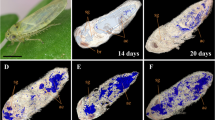Summary
The chronology of PLRV acquisition and retention byMyzus persicae was investigated using electron microscopy. Examination demonstrated a rapid translocation of the virus through the intestine into the haemocoel. Indeed, viral particles could be observed in the intestinal epithelial cells, then in the haemocoel, 4 and 8 h, respectively, after their arrival in the lumen of the alimentary canal. However, the virus accumulated in the intestinal epithelial cells. In these cells, the first viral particles were seen enclosed in isometric or tubular isolated vesicles; a few hours later, they were present in tubular aggregated vesicles and also in lysosomes or multivesicular bodies. After a 40 h acquisition period, all studied intestinal epithelial cells exhibited high numbers of viral particles which were consistently distributed throughout these cell structures. When aphids were removed from viral source, viral particles were detected in intestinal lumen for a further three days and in intestinal epithelial cells for a total of eight days. Virus content in these cells began to decrease from the second day. Areas with tubular aggregated vesicles were maintained for seven days following aphid removal from viral source, but progressively became smaller and fewer. The accumulation and the persistence of PLRV in the intestine are discussed.
Similar content being viewed by others
References
Eskandari F, Sylvester ES, Richardson J (1979) Evidence for lack of propagation of potato leaf roll virus in its aphid vector,Myzus persicae. Phytopathology 69: 45–47
Garret A, Kerlan D, Thomas D (1991) Visualization of a luteovirus in the vector aphid's body by two gold immunolabelling techniques: a comparative study. J Virol Methods 35: 93–107
Garret A, Kerlan C, Thomas D (1993) The intestine is a site of passage for potato leafroll virus from the gut lumen into the haemocoel in the aphid vector,Myzus persicae Sulz. Arch Virol 131: 377–392
Gildow FE (1982) Coated-vesicle transport of luteoviruses through salivary glands ofMyzus persicae. Phytopathology 72: 1289–1296
Gildow FE (1985) Transcellular transport of barley yellow dwarf virus into the haemocoel of the aphid vector,Rhopalosiphum padi. Phytopathology 75: 292–297
Gildow FE (1987) Virus-membrane interactions involved in circulative transmission of luteoviruses by aphids. In: Harris KF (ed) Current topics in vector research, vol 4. Springer Berlin Heidelberg New York Tokyo, pp 93–120
Gildow FE (1993) Evidence for receptor-mediated endocytosis regulating luteoviruses acquisition by aphids. Phytopathology 83: 270–277
Gildow FE, Rochow WF (1980) Role of accessory salivary glands in aphid transmission of barley yellow dwarf virus. Virology 104: 97–108
Gildow FE, Gray SM (1993) The aphid salivary gland basal lamina as a selective barrier associated with vector-specific transmission of barley yellow dwarf luteoviruses. Phytopathology 83: 1293–1302
Hardy JL, Houk EJ, Kramer LD, Reeves WC (1983) Intrinsic factors affecting vector competence of mosquitoes for arboviruses. Ann Rev Entomol 28: 229–262
Harrison BD (1984) Potato leafroll virus. Descriptions of Plant Viruses, No. 291
Miyamoto S, Miyamoto Y (1966) Notes on aphid-transmission of potato leafroll virus. Sci Rep Hyogo Univ Agric 7: 51–66
Ponsen MB (1972) The site of potato leafroll virus multiplication in its vector.Myzus persicae. An anatomical study. Meded Landbouwhogeschool Wageningen, pp 72–16
Stegwee D (1960) Further investigations on the relation betweenMyzus persicae and the potato leafroll virus. Proc Conf Potato Virus Diseases Brauschweig, pp 106–110
Stegwee D, Ponsen MB (1958) Multiplication of potato leaf roll virus in the aphidMyzus persicae (Sulz). Entomol Exp Appl 1: 291–300
Sugawara M. Kojima M, Murayama D (1973) Further studies on the transmission and retention of inoculativity of potato leaf-roll virus in its vector,Myzus persicae. Ann Phytopathol Soc Japan 39: 410–416
Sugawara M, Kojima M, Murayama D (1974) Latent period of potato leaf-roll virus in its vector,Myzus persicae. Ann Phytopathol Soc Japan 40: 39–45
Tamada T, Harrison BD (1981) Quantitative studies on the uptake and retention of potato leafroll virus by aphids in laboratory and field conditions. Ann Appl Biol 104: 107–116
Van Den Heuvel JFJM, Peters D (1990) Transmission of potato leafroll virus in relation to the honeydew excretion ofMyzus persicae. Ann Appl Biol 116: 493–502
Weidemann HL (1982) Zur Vermehrung des Kartoffelblattrollvirus in der BlattlausMyzus persicae (Sulz). Z Angew Entomol 94: 321–330
Author information
Authors and Affiliations
Rights and permissions
About this article
Cite this article
Garret, A., Kerlan, C. & Thomas, D. Ultrastructural study of acquisition and retention of potato leafroll luteovirus in the alimentary canal of its aphid vector,Myzus persicae Sulz. Archives of Virology 141, 1279–1292 (1996). https://doi.org/10.1007/BF01718830
Received:
Accepted:
Issue Date:
DOI: https://doi.org/10.1007/BF01718830




